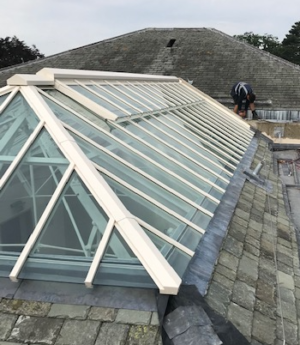Making heritage buildings greener


By Tracey Jackson, business development manager for Howells Patent Glazing.
The cost-of-living crisis has caused many of us to consider the energy efficiency of our homes. Turning lights off; not over-filling the kettle; turning the thermostat down a few degrees, everyone is finding little ways to cope with the rising cost of energy.
But what do you do if you’re in charge of some of the country’s most inefficient buildings?
When it comes to our historic buildings and heritage, it’s not as simple as turning the lights off, being more frugal with the heating and adding some insulation. It is far more nuanced than that. And this is the challenge facing national organisations like English Heritage, Historic Scotland and the National Trust.
English Heritage, for example, manages more than 400 buildings, monuments and places. This estate has a direct carbon footprint of a whopping 4,400 tonnes of CO2 per year. The organisation hopes to reduce this by 20% by 2025 and aims to reach net zero by 2040.
In a recent interview, Ruth Knight, English Heritage head of climate and sustainability, spoke about the charity’s climate action plan: “Our carbon reduction programme is ambitious,” she said. “To achieve our goals, we will be tapping into the wider expertise of the construction industry – modular building, digital innovation, renewable energy installations.”
In compiling the action plan, English Heritage found that “…10 sites accounted for 52% of all our carbon emissions.” ‘Half its direct emissions come from electricity and another 26% from gas so energy efficiency is a priority over the next two years.’
The challenge of course is the transition risk. “We have to walk a fine line – reducing carbon emissions and complying with the legislation, while conserving our historic places and maintaining our reputation as a responsible charity,” continued Ruth.
The action plan is already well under way with electrical upgrades, window repair and insulation.
Ruth is also quick to point out the importance of appointing skilled contractors, “…you need skilled contractors who will understand the sensitivity of the building fabric,” she said. However, she also acknowledges that traditional skills are in short supply. More generally, “…our sustainability strategy will be about trying to use local materials, local crafts, local skills wherever we can.”
With over 400 designated places this provides many manufacturers, contractors, and skilled tradespeople with ample opportunity to get involved. This is particularly pertinent for those sharing English Heritage’s climate commitment as ‘…[it] will expect 80% of its large suppliers to have their own public net zero commitments and action plans.’
While we may be an SME, this is something we too are actively exploring. It’s early days but we are working with a carbon consultancy to find ways to improve our carbon footprint. We’ve already switched over to LED lighting, for example, and in time and with investment our efforts will certainly benefit the projects we supply.
In addition to the numerous benefits associated with reducing our carbon footprint, we are also a proven supplier to English Heritage, the National Trust and for many historic buildings and conservation projects across the UK. This means we have a responsibility to ensure our products and processes match their ethos and continue to meet their requirements.
Our aluminium glazed products are frequently used for replacing glazed features on historic buildings. For example, we supplied and installed a replacement glazed roof with vents for the historic squash court at Ickworth, an Italianate Palace which is cared for by the National Trust.
Our aluminium patent glazing and roof lights not only help conserve old, prestigious buildings and their contents, but they also perform to a modern specification.
This means that spaces stay dry, the indoor temperature can be better regulated, with ventilation, and there’s plenty of controlled natural daylight. Altogether, products such as ours contribute to the energy efficiency of the building, whatever their age, and help make our historic places greener and more sustainable.